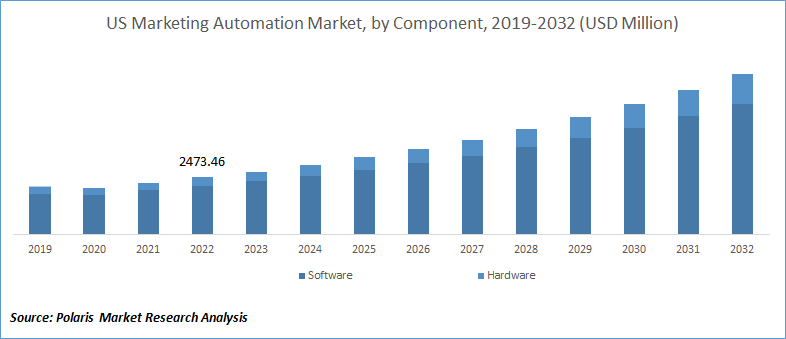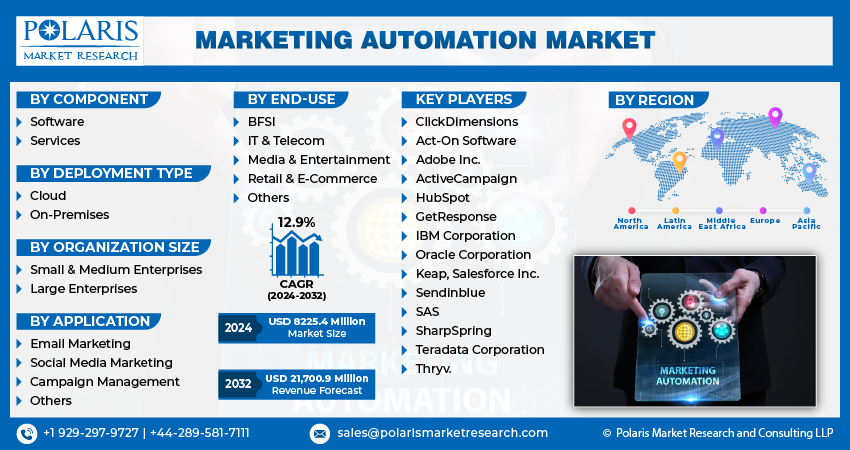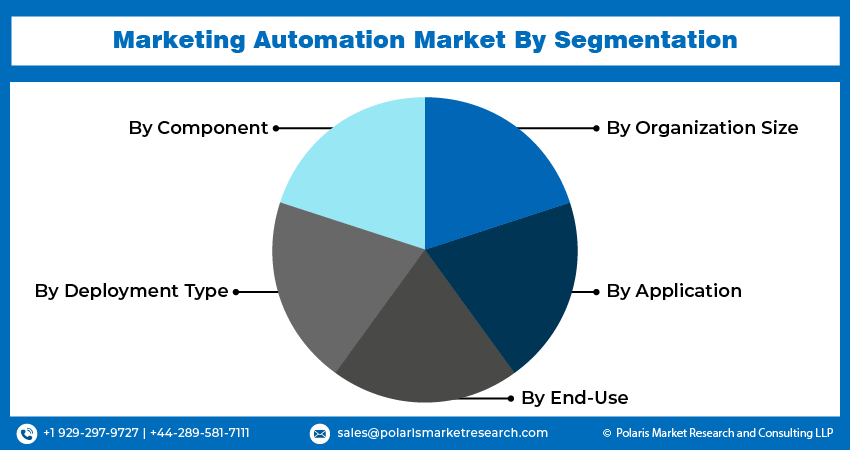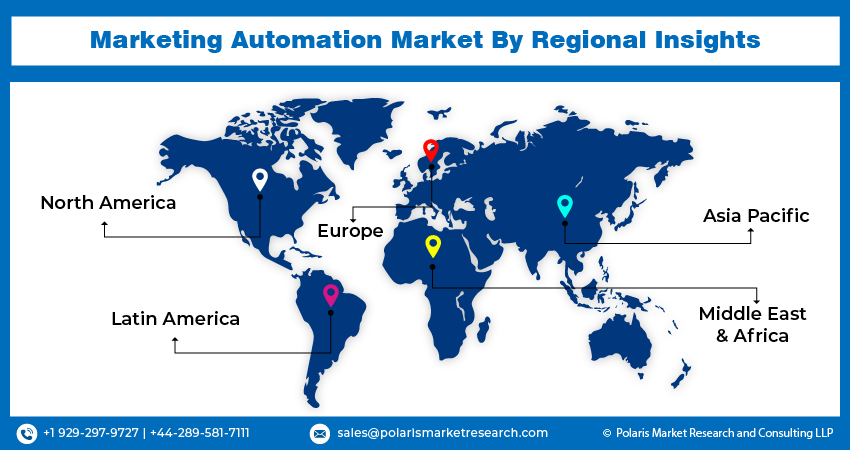
Marketing Automation Market Size, Share, Trends, & Industry Analysis Report
By Component (Software, Services), By Deployment Type, By Organization Size, By Application, By End-Use, By Region – Market Forecast, 2025–2034
- Published Date:Oct-2025
- Pages: 115
- Format: PDF
- Report ID: PM2644
- Base Year: 2024
- Historical Data: 2020-2023
What is Marketing Automation Market Size?
The global marketing automation market was valued at USD 6.85 billion in 2024 and is expected to grow at a CAGR of 15.7% during the forecast period. The growing focus on personalized customer engagement and technological advancement is driving the growth.
Key Insights
- The cloud-based segment is expected to witness significant growth during the forecast period due to its flexibility and cost effectiveness.
- The IT & telecom dominated with largest share in 2024 to its large consumer base.
- North America dominated with largest share in 2024 due to high digital adoption in the region.
- Asia Pacific is projected to accounted for a significant share in the global market driven by increasing adoption of digitalization in countries such as China, India, Japan, Singapore, and others.
Industry Dynamics
- The growing competition among the business is fueling the market growth.
- The rising focus on personalized customer engagement is driving the growth.
- The technological advancement is boosting the industry growth.
- High initial implementation costs and complexity of integration with existing systems are limiting the adoption.
Market Statistics
- 2024 Market Size: USD 6.85 Billion
- 2034 Projected Market Size: USD 29.24 Billion
- CAGR (2025-2034): 15.7%
- Largest Market: North America
Impact of AI on Industry
- Improves personalization by enabling real-time, hyper-personalized marketing with the help of consumer behavior analysis.
- Automates and refines audience segmentation based on dynamic data patterns, enabling more targeted campaigns.
- Enables faster, data-driven decision-making, which reduce manual intervention and increasing campaign efficiency.

To Understand More About this Research: Request a Free Sample Report
Marketing automation uses technology and software platforms to automate various marketing tasks, processes, and workflows. It is designed to streamline and optimize marketing activities, improve efficiency, and enhance customer engagement. its also permits industries to automate repetitive marketing tasks such as social media posting, email marketing, customer segmentation, main nurturing, campaign tracking, and reporting. It helps marketers deliver the right message to the right audience at the right time based on predefined triggers and customer behavior.
Marketing automation offers a higher return on investment than traditional marketing methods. The market for automation software surrounds various techniques and tools that streamline and integrate social media, multichannel campaigns, web marketing, and content marketing. Marketing automation identifies potential customers and automates the procedure of nurturing sales information. This component supplies customers with all the necessary information, allowing sales representatives to engage directly with clients and explain additional features. It expedites the sales process and enables the sales team to close deals more efficiently. Moreover, marketing automation has become an integral part of organizational structures. Automation processes have expanded and evolved with the increasing adoption of IoT-connected devices.

Industry Dynamics
Growth Drivers
What Factors are Driving the Marketing Automation Market?
The marketing automation market is growing due to several factors such as rising focus on personalized marketing, rising adoption of digital marketing tools, and growing emphasis on return on investment. Businesses currently are focusing on personalized customer engagement due to rising competition, customer expectations and probability of better conversion rates. This has increased the demand for the marketing automation tools among the businesses. Marketing automation enables segmentation, behavior tracking, and targeted messaging, which help companies to engage with the right audience at the right time with the right content. Moreover, the competition among the business has increased due to technological, economic, and consumer-driven factors that have lowered barriers to entry and raised customer expectations. This has further fueled the demand for the marketing automation tools to offer personalized experiences which helps companies to stand out, thereby driving the industry growth..
Report Segmentation
The market is primarily segmented based on component, deployment type, organization size, application, end-use, and region.
|
By Component |
By Deployment Type |
By Organization Size
|
By Application |
By End-Use |
By Region |
|
|
|
|
|
|
To Understand the Scope of this Report: Speak to Analyst
Why IT & Telecom Accounted for Largest Share in 2024?
The IT & telecom segment accounted for largest share in 2024 due to its widespread consumer base. Telecom and IT companies manage millions of users, requiring automation to deliver personalized marketing at scale. These sectors are inherently digital, making it easier to integrate and adopt marketing automation tools for customer engagement. Companies are adopting the automation tools to frequently run campaigns on new product launches and any upgrade to existing product such as 5G, cloud, or cybersecurity. Moreover, marketing automation tools reduce the cost of the marketing campaigns which is fueling the adoption among the IT and Telecom companies, thereby driving the segment growth.

Which Segment by Deployment Type is Expected to Witness Significant Growth?
The cloud based segment is expected to witness significant growth during the forecast period due to its flexibility and cost effectiveness. Cloud-based deployment offers marketing teams to collaborate and manage campaigns from anywhere, which enable real-time updates and faster decision-making. This remote accessibility reduces the upfront cost of expensive hardware and IT infrastructure, which in turn is driving its adoption among SMEs and large enterprises. Moreover, cloud marketing automation tools easily integrate with CRM, analytics, and social media platforms, which streamlines marketing operations, thereby driving the segment growth.
What are the Reasons for Asia Pacific's Significant Growth?
The Asia Pacific region is expected to witness significant growth during the forecast period due to the increasing adoption of digitalization in countries such as China, India, Japan, Singapore, and others. Major countries such as China has a highly active social media environment with one of the largest Internet user bases globally. While social networking sites like Facebook and Twitter are banned in China, platforms like Sina Weibo have gained immense popularity with millions of daily users. In India, the "Digital India" campaign has led to a significant digital revolution, promoting digitalization across various sectors. The country has also witnessed a substantial increase in internet penetration and e-commerce activities, which have considerably impacted the growth of the marketing automation industry in India. Also, the rising digitalization trends and internet usage in the Asia Pacific region are driving the demand for marketing automation solutions, creating favorable opportunities for growth in the industry.
How North America Captured Largest Market Share in 2024?
The North America dominated with largest share in 2024 due to high digital adoption in the region. The region has a mature digital ecosystem with widespread use of CRM, AI, and data analytics tools which makes marketing automation a natural progression. The region also has the presence of major automation companies such as Salesforce, HubSpot, Adobe, and Oracle which fuels the accessibility. Moreover, the e-commerce and B2B market in the region is growing due to increase in the smartphone and internet penetration. This growth fuels the demand for the marketing automation tools to manage large customer base efficiently. Companies in North America prioritize personalized customer experiences, which are effectively delivered through marketing automation technologies, thereby driving the industry growth in the region.

Competitive Insight
Some of the major players operating in the global market include ClickDimensions, Act-On Software, Adobe Inc., ActiveCampaign, HubSpot, GetResponse, IBM Corporation, Oracle Corporation, Keap, Salesforce Inc., Sendinblue, SAS, SharpSpring, Teradata Corporation, Thryv.
Recent Developments
- February 2024: HubSpot and Microsoft Dynamics 365 announced a partnership to offer shared customers easier workflows and more integration. According to HubSpot, organizations using both platforms are expected to benefit from this partnership since it will facilitate data sharing, automate processes, and increase visibility into marketing and sales activity.
- October 2023: Phonexa partnered with Tipalti, a payment automation platform, to launch an integration for its clients that aims to make global payment methods automated, compliant, and easier for affiliate marketing agencies and publishers to use.
- In September 2021, Oracle Corporation unveiled the Oracle Fusion Marketing System, an innovative platform that leverages artificial intelligence (AI) to automate key aspects of digital marketing campaigns. This system streamlines and enhances the efficiency of marketing processes by utilizing advanced AI capabilities.
- In January 2020, IBM Corporation expanded its product portfolio by introducing Advertising Accelerator with Watson. This solution harnesses the power of artificial intelligence technology provided by Watson to create captivating and engaging digital marketing campaigns. By leveraging AI, IBM aimed to deliver customers personalized and impactful advertising experiences.
Marketing Automation Market Report Scope
|
Report Attributes |
Details |
|
Market size value in 2024 |
USD 6.85 billion |
| Market size value in 2025 | USD 7.89 billion |
|
Revenue forecast in 2034 |
USD 29.24 billion |
|
CAGR |
15.7% from 2025 – 2034 |
|
Base year |
2024 |
|
Historical data |
2020 – 2023 |
|
Forecast period |
2025 – 2034 |
|
Quantitative units |
Revenue in USD billion and CAGR from 2025 to 2034 |
|
Segments Covered |
By Component, By Deployment Type, By Organization Size, By Application, By End-Use, By Region |
|
Regional scope |
North America, Europe, Asia Pacific, Latin America, Middle East & Africa |
|
Key Companies |
ClickDimensions, Act-On Software, Adobe Inc., ActiveCampaign, HubSpot, GetResponse, IBM Corporation, Oracle Corporation, Keap, Salesforce Inc., Sendinblue, SAS, SharpSpring, Teradata Corporation, Thryv. |
FAQ's
The global marketing automation market size is expected to reach USD 29.24 billion by 2034.
Key players in the market are ClickDimensions, Act-On Software, Adobe Inc., ActiveCampaign, HubSpot, GetResponse, IBM Corporation, Oracle Corporation.
Asia Pacific region contribute notably towards the global Marketing Automation Market.
The global marketing automation market is expected to grow at a CAGR of 15.7% during the forecast period.
Key segments in the Marketing Automation Market component, deployment type, organization size, application, end-use and region.
